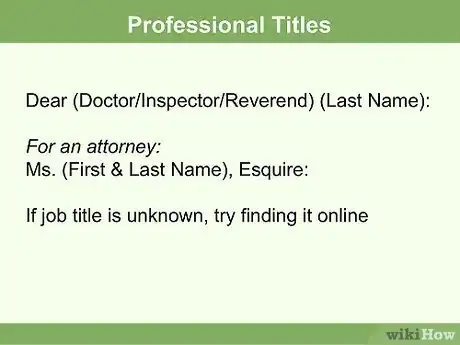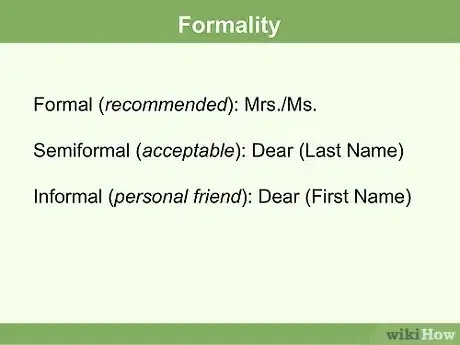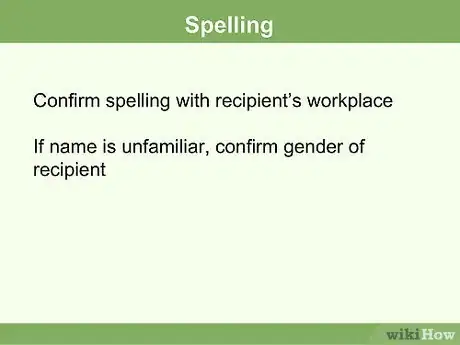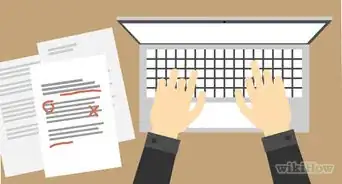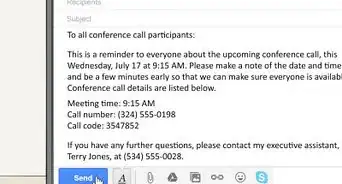This article was co-authored by Michael R. Lewis. Michael R. Lewis is a retired corporate executive, entrepreneur, and investment advisor in Texas. He has over 40 years of experience in business and finance, including as a Vice President for Blue Cross Blue Shield of Texas. He has a BBA in Industrial Management from the University of Texas at Austin.
This article has been viewed 438,623 times.
A business letter uses a formal tone, and has specific requirements for salutations -- greetings that specifically reference the intended reader. An improperly drafted business letter could offend a potential employer, client or partner and damage your business relationship as a result. When you address a woman in a business letter, you should always use any professional title she may have (such as "Dr. or "Rev."); if she does not have a professional title, use a general title based on her marital status: "Ms." when she is unmarried or if her marital status is unknown, or "Mrs." if you know she's married.
Steps
Part 1: Choosing The Correct Title
-
1Confirm if you know the recipient's name. If you know the recipient's name, proceed to the following steps. If not, read the remainder of this step.
- It sometimes occurs that you will need to address a women without knowing her name. In this case, use Dear Madam. If you are not aware of the gender either, you can use "To whom it may concern".[1]
-
2Determine if the recipient has a professional title or designation. If the woman you are sending the business letter to has some professional designation or title, be sure to address her accordingly. In this case, referring to gender is not necessary.
- Start with a formal salutation such as “Dear” and follow it by the job title of the intended reader, followed by their full name. If you do not know if the reader has a formal title, be sure to look it up first by searching the organizations website or asking somebody. By using the job title of the intended reader you can avoid having to worry about using gender-specific titles.
- For example, if you're writing a business letter to an Inspector, your business letter salutation would be “Dear Inspector”. This alone could be the entire salutation, or “Dear Inspector” could be followed by the intended reader's last name. The same would apply if the woman if a Doctor, and in this case, the letter could begin with "Dear Dr.Johnson", for example.
- Use the correct salutation for a minister. Use the minister's first and last name in the address in the form, "Reverend Jane Doe," or "Pastor Jane Doe." In the salutation, it is acceptable to abbreviate the term "Reverend" but not the term "Pastor," so you would use the form, "Dear Rev. Doe," or "Dear Pastor Doe.
- The correct salutation for an attorney is “Mrs./Ms/Mr. [First & Last Name], Esquire”, or “Mrs./Ms/Mr. [First & Last Name], Esq.”
Advertisement -
3Confirm if you know the recipient's marital status or not. The proper salutation of a woman depends largely on her marital status. If you are unsure of the recipient's marital status, and she does not have a formal title or professional designation, it is possible to use "Dear [the first and last name of the recipient]. For example, Dear Jennifer Johnson.
- In addition, it is also possible to use "Ms." for women whose marital status you are unsure of.
-
4Use the following titles if you do know the recipient's marital status. There are three basic ways to address a woman.[2]
- "Mrs.” is used for married women.
- "Ms.” is used for both married and unmarried women. Use this formal title when the woman's marital status is unknown or irrelevant.
- "Miss.” is used for unmarried women. Avoid using this formal title because its use is often considered to be condescending to the reader, especially when used to address an older woman.
Part 2: Polishing Your Greeting
-
1Ensure you are using the proper level of formality. The use of the titles “Mr.”, “Mrs”, “Miss” or “Ms.” before a full name or last name, is a relatively formal practice, and there are certain circumstances whereby you would use that level of formality, and when you would not.[3] "
- If you have a pre-existing relationship with the reader, or the circumstances dictate that the letter not be exceptionally formal, it is possible to not use the formal titles. For example, if you are contacting a business partner or someone whom you know or have a relationship with, you can simply use Dear [First Name] rather than a formal title.[4]
- A formal title should always be used when the formal salutation only includes the intended reader's last name, ie. "Mrs./Ms/Mr. [Last Name]". A formal title may not be necessary when using both the first and last name.
- Be cautious with using no formal title. Avoid using a woman's first name in the salutation, unless you know her well. Otherwise, a formal salutation should be used, followed by a colon in order to avoid a false presumption of intimacy. For example, "Dear Ms. Brown:" or Dear Ms. Lucy Brown:”, should be used instead of "Dear Lucy.
-
2Verify the proper spelling of the intended reader's name. A name can often be used to determine the intended reader's gender, which will help you to decide which formal title to address the reader by. Even if you have the businesswoman's name, you should still make sure the name is spelled correctly in order to avoid offending the reader in the first few sentences of your letter.
- A receptionist or human resource employee of the intended reader can verify the proper and correct spelling of the intended reader's name and functional title.
- When writing a business letter to an unknown party, you should attempt to verify the proper spelling of the intended reader's name in order to determine gender, and thus the necessary formal title.
-
3Ensure you are adhering to proper punctuation. There are certain punctuation rules surrounding both the title (Mrs, Miss ,Ms) and the salutation (Dear).
- In American English, the titles are usually written followed by a period. For example "Dear Ms. Johnson". In British English, periods are typically not used. For example, "Dear Ms Johnson".[5]
- In American English a colon typically follows the person's name. For example, "Dear Ms. Johnson: ". In British English, no colon is used, so it would read "Dear Ms Johnson".[6]
Warnings
- Never use "To Whom It May Concern." This phrase is overused and will appear too generic to the reader. If you don't know the correct name, contact the business or organization to find out.⧼thumbs_response⧽
References
- ↑ https://www.ego4u.com/en/business-english/communication/business-letter/salutation
- ↑ https://www.ego4u.com/en/business-english/communication/business-letter/salutation
- ↑ https://www.englishclub.com/speaking/titles.htm
- ↑ https://www.businesswritingblog.com/business_writing/2006/01/greetings_and_s.html
- ↑ https://www.ego4u.com/en/business-english/communication/business-letter/salutation
- ↑ https://www.ego4u.com/en/business-english/communication/business-letter/salutation
About This Article
To address a woman in a business letter, write "Dear Madam" as a greeting if you don't know her name. If you know her name, you can use "Mrs" if she's married, or "Ms" if you're not sure whether she's married. However, avoid using "Dear Miss," since it can sometimes be thought of as condescending. You can also address a woman by using her job title, such as "Dear Inspector Jennifer Johnson." For tips on how to use the proper level of formality when addressing a woman, read on!

